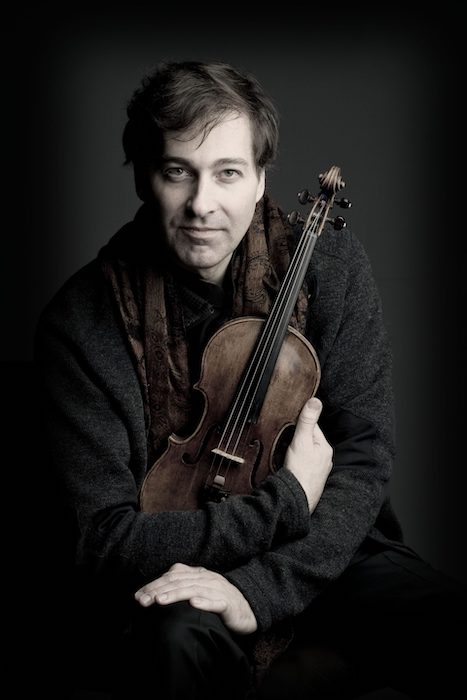Violinist makes strong case for lost Ysaÿe sonata in Rockport Festival premiere

Philippe Graffin performed the American premiere of a lost violin sonata by Eugène Ysaÿe Thursday night at the Rockport Chamber Music Festival. Photo: Marco Borggreve
In the summer of 2017, Philippe Graffin came upon something he did not expect. Combing through Eugène Ysaÿe’ s sketchbooks, the French violinist uncovered a nearly complete manuscript of an unpublished sonata for solo violin.
Like many violinists, Graffin had long been drawn to the difficulty and originality of the Belgian composer’s Six Sonatas for Solo Violin. But when he performed a reconstruction of this lost Seventh Sonata in its American premiere Thursday night at the Shalin Liu Performance Center as part of the Rockport Chamber Music Festival, one got the sense that Ysaÿe left some of his most effective musical ideas buried in that dusty sketchbook.
As with many of Ysaÿe’s sonatas, the Seventh mixes Bachian severity with mesmerizing technical feats. Spanning three movements that clock in at ten minutes, the work calls upon the soloist to unleash torrents of triple and quadruple stops. Wide arpeggios frame biting chromatic harmonies while left-hand pizzicatos accompany cascading runs. The outer movements propel forward in terpsichorean fashion.
Though he completed the first two movements, Ysaÿe abandoned the finale after twelve measures, and Graffin reconstructed it by reusing the descending pizzicato runs of the Fifth Sonata and the stark dance rhythms of the Sixth’s habañera. Doing so situates the music within Ysaÿe’s own compositional voice, and Graffin’s additions sounded idiomatic and never felt contrived or mechanical.
The heart of the score is the Canzona, where a chant-like melody picks up delicate harmonies as it unfolds. It is unique even within Ysaÿe’s sonatas, featuring neither the starkness of the “Dies Irae” paraphrases (from No. 2) nor the serenity of the “Ballade” (No. 3).
In Thursday night’s performance, Graffin’s expressive tone brought a human warmth to the Canzona, and the violinist tossed off the leaps and driving figures with fine control and technical polish. Each phrase built to a sure resolution in the dance-like finale. With a mix of technical fireworks and tender pages, Graffin’s reconstruction makes a worthy addition to Ysaÿe’s sonatas, works that lie at the heart of the violin repertoire.
Thursday’s concert also featured a rare treat with Georges Enescu’s Violin Sonata No. 3. This most unusual of the Romanian composer’s chamber works spices huge romantic gestures and impressionistic harmonies with exotic folk-inflected melodies.
Graffin and pianist Marisa Gupta vividly conveyed all of its grit and rustic abandon. The performance showcased each musician in wild technical flourishes that gave a sense of improvisatory freedom. Graffin’s passages in the first movement took on an appropriate roughness of tone, and Gupta played with a crispness that injected live-wire energy to the rolling figures and crashing dissonances.
In the atmospheric second movement, Graffin’s glassy harmonics floated effortlessly above Gupta’s soft phrases before the music swelled into robust dialogue. The duo carried that intensity into the finale, where their blazing runs brought rapturous applause.
A similar vitality marked their performance of Ernö Dohnányi’s Andante Rubato alla Zingaresca, from Ruralia Hungarica.
As in the Enescu sonata, piano tremolos recall the cimbalom. But Dohnányi’s short but attractive work is thoroughly lush and tuneful. Here too, Graffin and Gupta played with the verve of a folk duo, the music’s sweeping lines coiling into soft shapes before ebbing away.
The second half of the concert brought another curio—Ernest Chausson’s Concert for Violin, Piano, and String Quartet.
Though cast in the form of a French Baroque concerto, this plush and dramatic score reflects the heavy harmonic writing of César Franck as well as Massenet’s lyricism. Graffin, pianist Piers Lane, and the Rockport Festival Quartet played it with a sense of symphonic depth and grandeur.
The outer movements require a pianist with stellar technique, and Lane proved a fine fit, traversing Chausson’s trickling lines and bold statements with precision. In his own solo moments, Graffin played with songlike grace, while the string quartet—violinists Benjamin Bowman and Danny Koo, violist Barry Shiffman, and cellist Tom Wiebe—supported him with deep, smooth-toned resonance.
The Siciliana was less a dance that a series of waves, each line ebbing and flowing with gentle rubato. In the Grave, Graffin floated haunting phrases over Lane’s chromatic accompaniment to shift the music towards darkness. The ensemble drew out the coda with keen attention to each phrase, the music flowering in the final strains before fading into silence.
The Rockport Chamber Music Festival will host pianist Piers Lane in Chopin’s complete Nocturnes 8 p.m. Saturday at the Shalin Liu Performance Center. rockportmusic.org; 978-546-7391
Posted in Performances